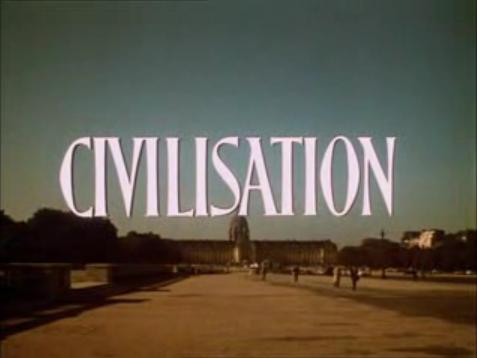How can civilisation be defined for the 21st century?
It would be tempting to brand Kenneth Clark’s 13-part documentary as the last gasp of an expiring ‘Eurocentric’ canon of culture


On Tuesday I saw civilisation – or one slice of it, at any rate – in an entirely new light. The light in question now floods Room 41 of the British Museum. In there, until now, a cramped and gloomy gathering of treasures from early-medieval Europe has unwittingly confirmed the old libel about the period as the “Dark Ages”. Coined by the church historian Caesar Baronius, the term referred simply to the scarcity of written sources at the time he wrote, around 1600.
Luminous after its revamp, Room 41 juxtaposes items from all over Europe and the near East around the cross-cultural glitz of the Sutton Hoo ship burial – that bling-stuffed grave of an East Anglian chieftain excavated in 1939. I had forgotten about the supersized silverware our Anglo-Saxon bigwig had in the early AD600s scooped up from around the Byzantine empire – very much The Only Way Is Suffolk. For curator Sue Brunning, the new display’s network of links and debts between Mercia and Egypt, Norway and Constantinople, illuminates “how all of these places related to each other across time and space”.
Rather than a cluster of separate poles and nodes, we see a grid or matrix, knitted together by trade, traffic, curiosity and mutual influence. In its own way, the refreshed Sutton Hoo gallery bears witness to a dozen years of curatorial reinvention by BM director Neil MacGregor. When MacGregor masterminded his ground-breaking exhibition-book-radio series A History of the World in 100 Objects, he told me that “if you keep looking around the world at the same moment, you do see all the societies differently. But, above all, you do see that the human family is not an empty metaphor.” His revolutionary tenure has delivered a globalised museum for a globalised metropolis.
Across town, on the same day, the BBC’s Director-General Tony Hall was unveiling the corporation’s expanded arts coverage. It will spend an extra £2.75m yearly on top of its £15.5m arts budget: still distinctly modest figures. And, with depressing cynicism, the BBC chose this week quietly to kill off The Review Show: the only TV slot for regular cultural criticism. In his peroration, Hall revealed plans for a digital‑age remix of Kenneth Clark’s Civilisation – the 1969 series commissioned by David Attenborough for BBC2 in ultra-modern colour. For Hall himself, it fostered “a lifelong passion” for the arts. “Where does our idea of Civilisation sit today,” the DG asked, “nearly half a century after Clark’s adventure?”
Answers on a postcard – or, rather, in a tweet – please. Framed in such stark terms, the Civilisation reboot sounds like a job for the electronic in-tray of Ian Fletcher – the hapless BBC “Head of Values” played by Hugh Bonneville in Auntie’s new satirical sitcom WIA. Still, as a starting point to measure the distance between then and now, MacGregor’s moulding of his Bloomsbury barn into what he calls a “comparative laboratory of societies and cultures” would appear to be – in a phrase Lord Clark of Saltwood never uttered – a no-brainer.
An example: also in 1939, exquisite 15th-century bronzes from the kingdom of Benin in Nigeria were first exhibited in Europe as high art, not as anthropological artefacts. In MacGregor’s words, “The realisation that bronze of that quality was being made before Cellini and at the same time as Donatello: that caused a sensation, a transformation in Europe’s understanding of Africa. It undercut all the racist assumptions that had made the colonial venture possible.”
It would be tempting to brand Clark’s 13-part documentary as the last gasp of an expiring “Eurocentric” canon of culture, rooted in the Renaissance and the heritage of Greece and Rome; ignorant of, or at best indifferent to, a wider world of art. His first episode even carried the title “The Skin of Our Teeth”. It gloried in the hair’s-breadth survival of classical values through the benighted chaos of those “Dark Ages” after the fall of Rome. Later segments focus in the expansive grand manner of patrician connoisseurship on the Italian Renaissance; the messy 20th century arrives, at last, almost as an afterthought. But Clark, as much as the artworks he revered, deserves to be placed in context. His subtitle “a personal view” signalled the subjectivity of the whole enterprise. Meanwhile, he made it plain that he knew and saluted the achievements of cultures beyond Europe.
Besides, his former fiefdom at the National Gallery – which he directed from 1934 to 1945 – had itself experienced a skin-of-the-teeth escape. As the London Blitz descended, Clark had in 1940 supervised the transfer of the paintings in his care to a slate mine near Blaenau Ffestiniog in North Wales for wartime safe keeping. To a scholar and aesthete of his vintage, civilisation as he understood it had just scraped through a near-fatal sickness incubated from within. Neither had calm waters yet returned. In 1968, Clark and director Michael Gill were filming in Paris at the time of the May uprisings. That cultural volcano would solidify many of the ideas that sought to topple the Western legacy from its perch atop a pedestal of esteem. Clark’s concept of civilisation did not grow out of a mood of smug security. He inventoried a museum still at risk. As much elegiac as triumphalist, Clark sees the shadows lengthen through the gallery.
The cameras had scarcely stopped rolling before the critiques got under way. Indeed, many of the class-of-68 master-thinkers who did so much to reframe or fragment the Western canon had already launched their intellectual missiles: Claude Lévi-Strauss’s The Savage Mind in 1962; Michel Foucault’s The Order of Things in 1966; three seminal works by Jacques Derrida in 1967. The year after Civilisation saw the publication of Germaine Greer’s The Female Eunuch – one of several feminist revisions of a cultural menu that excluded half the human race. In 1972 came the trail-blazing BBC series Ways of Seeing, written by John Berger and directed by Mike Dibb. A fairly explicit riposte to the Clark agenda, Ways of Seeing highlighted the inequities of status and property ignored in mainstream art history. For Berger, power and money talked even through the smile of a radiant Florentine madonna.
Students soon learnt the dictum of Walter Benjamin, the great German critic who had died in 1940 on the run from the Nazi version of Kultur (as opposed to mere Zivilisation, an inferior term in German post-Romantic thought). For Benjamin, in his Theses on the Philosophy of History, “There is no document of civilisation which is not at the same time a document of barbarism.” The blood of helots soaks the sand around the pyramids. Pillage and extortion enrich the Medicis and Sforzas who fund the grandeur of a Leonardo or a Michelangelo. Peasants gnaw on roots so that feudal clerics can edify a Chartres or a Salisbury. I once heard the outstanding historian of slavery Orlando Patterson speak in his home island of Jamaica. “If you want to see the wealth of Jamaica, go to Britain,” he advised. “Whenever I go to the Tate [as in Tate & Lyle sugar] Gallery, I feel a sense of proprietorship.”
The incoming fire only intensified. Except when it overlapped with his heartlands in the Renaissance and Enlightenment, Clark had also turned a blind eye to scientific progress. Within a few years the BBC had hastened to fill that yawning black hole with The Ascent of Man (1973), Jacob Bronowski’s equally illustrious panoramic series. Clark’s Civilisation had also averted its elegant gaze from Europe’s colonial plunder and appropriation of other people’s treasures and traditions. Game-changing studies such as Edward Said’s Orientalism (1978) would soon shift the balance of scholarly power.
So the series reached TV screens at a moment of swings and hinges, as new doors opened. The giant task that awaits any next-generation successor will be to resurvey the original terrain and incorporate those extra layers of challenge and critique. Any producer or presenter landed with that mission deserves both envy and pity.
But crude pluralism will not be enough. Civilisation: the Digital Remix cannot just correct Lord Clark’s oversights and omissions by bolting on precast sections of Karnataka dance, Malian kora and Aboriginal bark art. The inter-cultural model on show at the BM may at present offer the most coherent upgrade to the Clark marque. It chooses to privilege the arts and acts of fusion and transfusion that bind one world to another. Back in Room 41, I was awestruck by the Franks Casket – a Northumbrian whale-ivory box from around AD700. It depicts Roman, pagan and Christian stories happily side by side, Wayland the Smith rubbing shoulders with the Adoration of the Magi.
However broad their remit, the producers of Civilisation 2.0 will have to shape and route all its material. The remake will need to tell a fresh story, not pile up the global goodies; to trace an arc of meaning as well as a line of beauty. Perhaps this is a job for the Head of Values after all.

Join our commenting forum
Join thought-provoking conversations, follow other Independent readers and see their replies